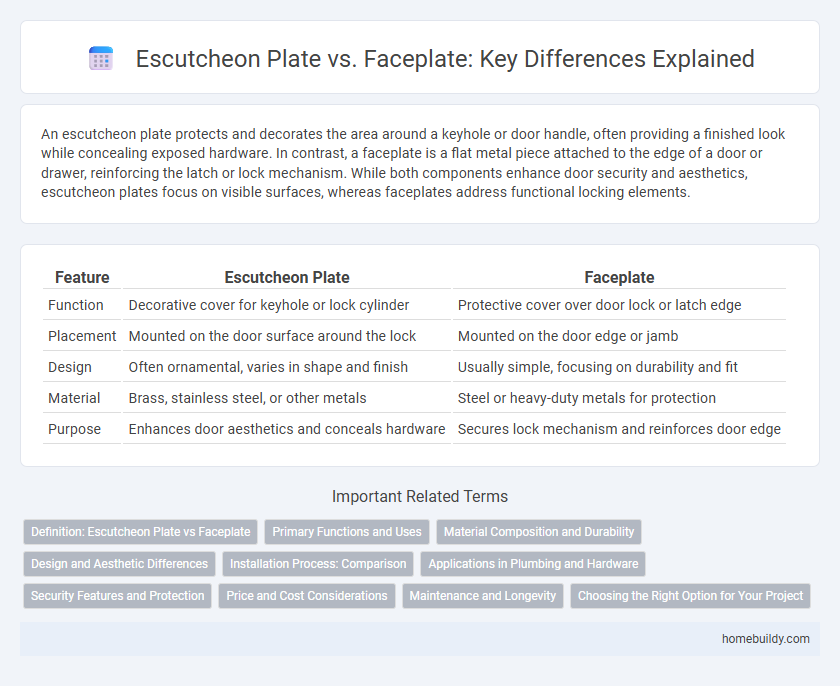An escutcheon plate protects and decorates the area around a keyhole or door handle, often providing a finished look while concealing exposed hardware. In contrast, a faceplate is a flat metal piece attached to the edge of a door or drawer, reinforcing the latch or lock mechanism. While both components enhance door security and aesthetics, escutcheon plates focus on visible surfaces, whereas faceplates address functional locking elements.
Table of Comparison
| Feature | Escutcheon Plate | Faceplate |
|---|---|---|
| Function | Decorative cover for keyhole or lock cylinder | Protective cover over door lock or latch edge |
| Placement | Mounted on the door surface around the lock | Mounted on the door edge or jamb |
| Design | Often ornamental, varies in shape and finish | Usually simple, focusing on durability and fit |
| Material | Brass, stainless steel, or other metals | Steel or heavy-duty metals for protection |
| Purpose | Enhances door aesthetics and conceals hardware | Secures lock mechanism and reinforces door edge |
Definition: Escutcheon Plate vs Faceplate
An escutcheon plate is a protective or decorative cover that surrounds a keyhole or lock cylinder on a door, emphasizing aesthetic and security functions. A faceplate is a flat metal or plastic plate mounted on the edge of a door or drawer to reinforce the lock mechanism or latch. Unlike faceplates, escutcheon plates primarily focus on covering and enhancing visibility around the lock area rather than reinforcing the locking mechanism itself.
Primary Functions and Uses
An escutcheon plate primarily serves as a decorative and protective cover for keyholes, lock cylinders, or door handles, preventing wear and tampering while enhancing aesthetic appeal. In contrast, a faceplate is a metal plate attached to the edge of a door, reinforcing the door latch and bolt area to ensure proper alignment and security. Escutcheon plates emphasize ornamental protection around hardware openings, whereas faceplates focus on structural reinforcement and latch functionality.
Material Composition and Durability
Escutcheon plates are typically made from metals such as brass, stainless steel, or bronze, offering superior resistance to corrosion and wear compared to faceplates which are often constructed from plastic or lighter metals. This metal composition enhances the durability of escutcheon plates, making them ideal for protecting locking mechanisms and door hardware over long-term use. Faceplates, while easier to manufacture and install, generally lack the robust material integrity of escutcheon plates, resulting in reduced longevity under heavy or outdoor usage.
Design and Aesthetic Differences
An escutcheon plate typically features a minimalist, decorative design that conceals keyholes or lock mechanisms, enhancing the door's aesthetic without overwhelming its style. In contrast, faceplates are generally more functional and less ornate, designed primarily to cover and protect the latch or bolt area with a utilitarian appearance. The escutcheon plate often serves as a focal decorative element, available in various finishes and intricate patterns that complement architectural themes, whereas faceplates prioritize durability and compatibility with locking hardware.
Installation Process: Comparison
Escutcheon plates typically require precise alignment over door hardware holes, secured by screws or clips, ensuring a flush fit that prevents dust and debris entry. Faceplates, often installed within door edge recesses, demand chiseled mortises for accurate placement before screw fastening, making the process more labor-intensive. The escutcheon plate installation is generally quicker and less invasive compared to the faceplate, suitable for retrofits or decorative upgrades.
Applications in Plumbing and Hardware
Escutcheon plates serve as decorative and protective covers around plumbing fixtures, concealing pipe penetrations and preventing water damage, while faceplates primarily function as mounting surfaces for hardware like door locks or electrical switches. In plumbing, escutcheon plates ensure a clean finish around exposed pipes, enhancing both aesthetics and hygiene by sealing gaps. Hardware installations use faceplates to secure components firmly, but lack the sealing and protective benefits essential in plumbing applications.
Security Features and Protection
Escutcheon plates provide enhanced security features by reinforcing the area around door locks and preventing tampering or forced entry, offering superior protection compared to standard faceplates. They often incorporate hardened materials and anti-drill components to resist physical attacks and improve lock durability. Faceplates primarily serve as aesthetic covers without the additional protective benefits essential for robust security.
Price and Cost Considerations
Escutcheon plates generally offer a more cost-effective solution compared to faceplates due to their simpler design and material usage. While faceplates often incorporate additional decorative elements or integrated features, escutcheon plates focus primarily on functionality, resulting in lower manufacturing and installation costs. Budget-conscious projects benefit from choosing escutcheon plates to balance durability and affordability without compromising essential protective coverage.
Maintenance and Longevity
Escutcheon plates offer superior protection against moisture and corrosion compared to faceplates, reducing the frequency of maintenance required for door hardware. Made from durable materials such as brass or stainless steel, escutcheon plates enhance longevity by shielding keyholes and locking mechanisms from wear and environmental damage. Regular cleaning and lubrication of the escutcheon plate contribute to extending the lifespan of door components more effectively than standard faceplates.
Choosing the Right Option for Your Project
An escutcheon plate typically offers a decorative and protective function, covering keyholes or pipe penetrations while enhancing aesthetic appeal, whereas a faceplate primarily provides a functional cover for switches or outlets. Selecting the right option depends on the specific application, desired finish, and compatibility with existing hardware to ensure both visual cohesion and effective protection. Consider materials, dimensions, and installation requirements to match the escutcheon plate or faceplate with your project's design and durability needs.
escutcheon plate vs faceplate Infographic

 homebuildy.com
homebuildy.com